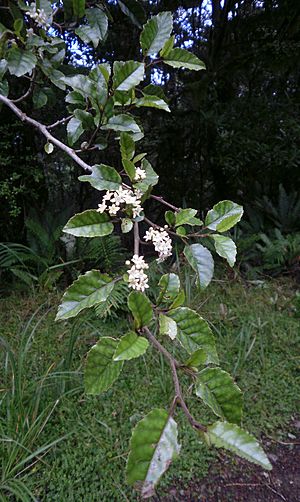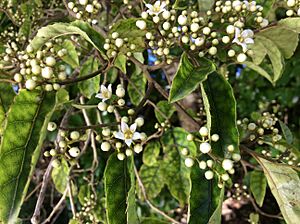Carpodetus serratus facts for kids
Quick facts for kids Carpodetus serratus |
|
|---|---|
 |
|
| Carpodetus serratus branch in flower | |
| Scientific classification | |
| Genus: |
Carpodetus
|
| Species: |
serratus
|
| Synonyms | |
|
|
The Putaputaweta (scientific name: Carpodetus serratus) is a cool evergreen tree that grows only in New Zealand. It has small, roundish leaves with jagged edges and a cool mottled (spotty) pattern. Its young branches grow in a zig-zag shape! In spring and summer, it gets sweet-smelling white flowers. Later, these turn into small, black, chewy berries. The name "putaputaweta" is Māori and means "many wētā emerge." This is because wētā, which are large, nocturnal insects, often live in holes in the tree's trunk. People also call it "marbleleaf" because of its pretty leaves. You can find this tree in forests across the North, South, and Stewart Island. It usually flowers from November to March, and its berries are ready from January to February.
Contents
About the Putaputaweta Tree
The Putaputaweta is a small tree that can grow up to 10 meters (about 33 feet) tall. Its trunk is usually thin, up to 30 centimeters (about 1 foot) wide. The bark is rough and corky, with a cool grey and white mottled look. It often has bumps from insects boring into it.
Young branches of the tree have a clear zig-zag shape. As the tree gets older, this zig-zag becomes less noticeable. You can also see small, raised pores called lenticels on the branches.
Leaves and Flowers
The leaves are thin but a bit leathery. They are usually broad and oval-shaped, about 4-6 cm long and 2-3 cm wide. They are dark green near the main veins and yellowish-green in between. The edges of the leaves are toothed, like a saw. The stems of the leaves and flowers are covered in soft, fuzzy hairs. The flowers grow in clusters called panicles, about 5 cm across. Each cluster can have up to fifteen or more small white flowers. Each flower is tiny, about 5-6 mm wide. They usually have five white petals. Inside the flower, you'll find stamens (which make pollen) and a stigma (which receives pollen). After the flowers, the tree grows small, round, fleshy berries. These berries turn black when they are ripe. Each berry has many tiny seeds inside.
How the Tree Got Its Name
The scientific name Carpodetus comes from two Greek words. "Karpos" means 'fruit', and "detus" means 'bound together'. This refers to how the seeds are grouped inside the berry. The second part of the name, serratus, is Latin and means 'shaped like a saw'. This describes the tree's jagged, saw-like leaf edges. The Māori name putaputawētā is very special. It means "many wētā emerge." This is because wētā (large, cricket-like insects) often hide in old holes in the tree's trunk. Another cool fact: freshly cut Putaputaweta wood has so much sap that it's hard to burn! This led to it sometimes being called the "bucket-of-water-tree."
Life in the Forest
Putaputaweta trees love moist forests. You can often find them in forests with Nothofagus trees, or along the edges of forests and streams. This tree is a home and food source for many creatures!
- The caterpillars of the puriri moth (Aenetus virescens) feed on the tree's inner bark. They make diamond-shaped scars and hide their burrows with a web. If too many caterpillars are on a young tree, it can make the tree weaker.
- Small brown bush ants (Prolasius advenus) like to drink the sap that drips from the wounds made by the caterpillars.
- Once a puriri moth caterpillar leaves its hole, tree wētā (Hemideina species) often move in! They use these holes as a safe place to rest during the day.
- At night, these tree wētā come out and munch on the leaves and fruits of the Putaputaweta tree. This is why the Tūhoe people sometimes call this tree "kaiwētā," which means "wētā food."
Growing Putaputaweta
The Marbleleaf tree is quite popular for gardens in New Zealand. It adapts well to being grown by people. When it's young, it stays a compact, rounded bush for several years. Then, it slowly grows into its adult tree shape. You can trim the tree to keep it bushy and compact if you want. If the tree is healthy and grows well, it will produce lots of beautiful flowers!


